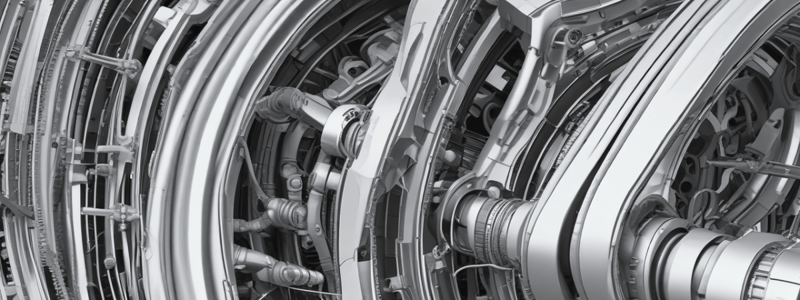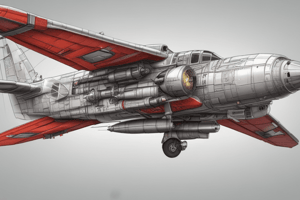Podcast
Questions and Answers
What is the purpose of rinsing all metals thoroughly after the quench?
What is the purpose of rinsing all metals thoroughly after the quench?
- To avoid corrosion caused by salt residue (correct)
- To speed up the aging process
- To cool the metal down
- To prevent warping and distortion
What happens to a heat-treatable aluminium alloy initially after being quenched?
What happens to a heat-treatable aluminium alloy initially after being quenched?
- It warps and distorts
- It needs immediate straightening
- It remains soft and weak (correct)
- It becomes harder and gains strength
How long does it take for an aluminium alloy with copper to become fully hard after being removed from the quench?
How long does it take for an aluminium alloy with copper to become fully hard after being removed from the quench?
- 4 or 5 days (correct)
- Several hours
- A day
- Several weeks
What is the term used for allowing an alloy to cool at room temperature after a quench?
What is the term used for allowing an alloy to cool at room temperature after a quench?
How can the aging process of an alloy be slowed down?
How can the aging process of an alloy be slowed down?
What can accelerate the aging process of a metal alloy?
What can accelerate the aging process of a metal alloy?
What is the unique purpose of the last two digits in alloys within the 1xxx Series?
What is the unique purpose of the last two digits in alloys within the 1xxx Series?
What is the principle alloying agent in alloys within the 2xxx Series?
What is the principle alloying agent in alloys within the 2xxx Series?
What is a major drawback of aluminium-copper alloys?
What is a major drawback of aluminium-copper alloys?
Which series of aluminium alloys have manganese as the principle alloying element?
Which series of aluminium alloys have manganese as the principle alloying element?
Among the 2xxx Series alloys, which type is commonly used in the construction of skins and rivets for aircraft?
Among the 2xxx Series alloys, which type is commonly used in the construction of skins and rivets for aircraft?
What feature is characteristic of alloys within the 1xxx Series?
What feature is characteristic of alloys within the 1xxx Series?
What type of aluminium alloy is used for the wing upper skin, spars, and beams on a passenger aircraft?
What type of aluminium alloy is used for the wing upper skin, spars, and beams on a passenger aircraft?
Which aluminium alloy provides exceptionally high strength and elasticity for aerospace applications?
Which aluminium alloy provides exceptionally high strength and elasticity for aerospace applications?
What is the main advantage of using Aluminium Alloy 7055 for the wing lower skin on an aircraft?
What is the main advantage of using Aluminium Alloy 7055 for the wing lower skin on an aircraft?
Which type of aluminium alloy is employed for the bulkheads, window frames, and landing gear beam on a passenger aircraft?
Which type of aluminium alloy is employed for the bulkheads, window frames, and landing gear beam on a passenger aircraft?
In which series are the 9xxx Series aluminium alloys classified?
In which series are the 9xxx Series aluminium alloys classified?
What type of aluminium is commonly used for most external aircraft surfaces?
What type of aluminium is commonly used for most external aircraft surfaces?
What element is most commonly found in Monel alloys?
What element is most commonly found in Monel alloys?
Which aircraft components specifically benefit from Monel's high strength and toughness properties?
Which aircraft components specifically benefit from Monel's high strength and toughness properties?
What characteristic of Inconel makes it suitable for turbine engines?
What characteristic of Inconel makes it suitable for turbine engines?
Which part of an aircraft might contain Monel rivets?
Which part of an aircraft might contain Monel rivets?
What is the primary advantage of using alloys containing titanium in modern jet transports?
What is the primary advantage of using alloys containing titanium in modern jet transports?
Which metal is commonly found in aircraft engine components such as fan blades and nozzle supports?
Which metal is commonly found in aircraft engine components such as fan blades and nozzle supports?
What does the letter 'T' followed by a number indicate in aluminium alloys?
What does the letter 'T' followed by a number indicate in aluminium alloys?
What does the designation T3 mean for an aluminium alloy?
What does the designation T3 mean for an aluminium alloy?
In the designation T36 for an aluminium alloy, what does the '36' represent?
In the designation T36 for an aluminium alloy, what does the '36' represent?
What is the main difference between T4 and T6 designations in aluminium alloys?
What is the main difference between T4 and T6 designations in aluminium alloys?
Why are the number of solution heat treatments limited for clad materials?
Why are the number of solution heat treatments limited for clad materials?
Why do rivets made of 2017 or 2024 receive several heat treatments?
Why do rivets made of 2017 or 2024 receive several heat treatments?
What process is used to develop hardness, strength, and corrosion resistance in metals by locking a metal's grain structure together?
What process is used to develop hardness, strength, and corrosion resistance in metals by locking a metal's grain structure together?
Which type of aging requires thermal treatment to develop full strength for alloys with high zinc content?
Which type of aging requires thermal treatment to develop full strength for alloys with high zinc content?
What is the purpose of annealing in the context of metals?
What is the purpose of annealing in the context of metals?
Why should clad aluminium metals be heated quickly and carefully during annealing?
Why should clad aluminium metals be heated quickly and carefully during annealing?
Which type of alloy derives its full strength at room temperature in a relatively short period without requiring further heat treatment?
Which type of alloy derives its full strength at room temperature in a relatively short period without requiring further heat treatment?
What happens if clad aluminium is exposed to excessive heat during annealing?
What happens if clad aluminium is exposed to excessive heat during annealing?
What is the primary characteristic of alloys within the 1xxx Series?
What is the primary characteristic of alloys within the 1xxx Series?
Why are aluminium-copper alloys like 2017 and 2024 susceptible to intergranular corrosion?
Why are aluminium-copper alloys like 2017 and 2024 susceptible to intergranular corrosion?
Which type of metallic changes occur in the grain structure of aluminium-copper alloys like 2017 and 2024?
Which type of metallic changes occur in the grain structure of aluminium-copper alloys like 2017 and 2024?
What is the principle alloying element in the 3xxx Series of aluminium alloys?
What is the principle alloying element in the 3xxx Series of aluminium alloys?
What is a distinctive feature of alloys within the 2xxx Series when compared to the 1xxx Series?
What is a distinctive feature of alloys within the 2xxx Series when compared to the 1xxx Series?
Which two commonly used alloys in aircraft structures belong to the aluminium-copper category?
Which two commonly used alloys in aircraft structures belong to the aluminium-copper category?
What does the second digit in the designation '1230' indicate for the aluminium alloy?
What does the second digit in the designation '1230' indicate for the aluminium alloy?
In the 5xxx series of aluminium alloys, which major alloying element is present?
In the 5xxx series of aluminium alloys, which major alloying element is present?
For the 9xxx series aluminium alloys, what does the first digit signify regarding the major alloying element?
For the 9xxx series aluminium alloys, what does the first digit signify regarding the major alloying element?
What does the designation '6050' represent for an aluminium alloy?
What does the designation '6050' represent for an aluminium alloy?
In the 2xxx series of aluminium alloys, which element serves as a major alloying agent?
In the 2xxx series of aluminium alloys, which element serves as a major alloying agent?
What is signified by the third and fourth digits in an aluminium alloy designation like '1100'?
What is signified by the third and fourth digits in an aluminium alloy designation like '1100'?
What does the 'T5' designation indicate for aluminium alloys?
What does the 'T5' designation indicate for aluminium alloys?
In the designation 'T3' for an aluminium alloy, what does the '3' represent?
In the designation 'T3' for an aluminium alloy, what does the '3' represent?
What is the purpose of reheat treating a material that has been previously heat-treated?
What is the purpose of reheat treating a material that has been previously heat-treated?
Why are the number of solution heat treatments limited for clad materials?
Why are the number of solution heat treatments limited for clad materials?
What characteristic differentiates T6 from T4 designations in aluminium alloys?
What characteristic differentiates T6 from T4 designations in aluminium alloys?
What effect does increased diffusion of core material into cladding have on clad materials?
What effect does increased diffusion of core material into cladding have on clad materials?
What is the primary reason copper is used in aircraft?
What is the primary reason copper is used in aircraft?
What makes Brass commonly used in aircraft electrical components?
What makes Brass commonly used in aircraft electrical components?
Why is beryllium copper identified as a hazardous material?
Why is beryllium copper identified as a hazardous material?
How is Inconel differentiated from stainless steel?
How is Inconel differentiated from stainless steel?
What is the main use of bronze in aircraft construction?
What is the main use of bronze in aircraft construction?
Why is neither copper nor its alloys commonly used as structural materials in aircraft construction?
Why is neither copper nor its alloys commonly used as structural materials in aircraft construction?
Study Notes
Heat Treatment and Quenching
- Rinsing metals thoroughly after quenching prevents residual contaminants from affecting mechanical properties and quality.
- Heat-treatable aluminium alloys experience rapid temperature changes that create a supersaturated solid solution after quenching.
- Aluminium alloys with copper typically take several hours to become fully hard post-quench, allowing time for the precipitation hardening process.
- Allowing an alloy to cool at room temperature after a quench is referred to as "aging" or "natural aging."
Aging Process
- Slowing down the aging process can be achieved by storing alloys at lower temperatures.
- Aging can be accelerated through higher temperatures or by adding certain alloying elements.
Aluminium Alloy Series
- The last two digits in alloys within the 1xxx Series indicate a specific alloy's purity and composition.
- Copper is the principal alloying agent in the 2xxx Series aluminium alloys.
- A major drawback of aluminium-copper alloys is their susceptibility to intergranular corrosion.
- Manganese serves as the principal alloying element in the 3xxx Series of aluminium alloys.
- Among the 2xxx Series, 2024 and 2017 alloys are commonly used for aircraft structural components like skins and rivets.
Characteristics of Aluminium Alloys
- Alloys within the 1xxx Series are characterized by high corrosion resistance and excellent electrical conductivity.
- 7075 aluminium alloy is utilized for wing structures due to its high strength and elasticity.
- 7055 aluminium alloy is preferred for wing lower skin applications due to its balance of strength and lightweight properties.
- Alloys used for bulkheads, window frames, and landing gear beams typically involve 2024 or 2017 alloys.
Other Alloy Types
- 9xxx Series aluminium alloys are classified mainly as specialty alloys.
- Most external aircraft surfaces are commonly made from 6061 or 2024 aluminium alloys.
- Monel alloys contain nickel and copper, known for their high strength and toughness, advantageous in various aircraft components.
- Inconel is characterized by its resistance to extreme temperatures, making it suitable for turbine engine applications.
Mechanical Properties and Designations
- The letter 'T' followed by a number denotes the thermal treatment and aging process an aluminium alloy has undergone.
- T3 indicates solution heat treatment followed by cold working, while T36 represents additional aging treatment that strengthens the alloy.
- The distinction between T4 and T6 designations lies in the aging process: T6 is artificially aged, while T4 is naturally aged.
- Clad materials have limited solution heat treatments to prevent core material diffusion that can jeopardize properties.
Additional Alloy Characteristics
- Annealing helps reduce stresses and improve ductility in metals.
- Clad aluminium should be heated quickly during annealing to minimize core material loss.
- Certain alloys achieve full strength at room temperature, offering quicker usability without further heat treatment.
- Excessive heat during annealing can cause delamination between cladding layers in clad aluminium.
Corrosion and Structural Integrity
- Aluminium-copper alloys are prone to intergranular corrosion due to their microstructural changes and grain structure.
- The core element for 3xxx Series alloys is typically manganese, enhancing formability and corrosion resistance.
Requirements for Aircraft Applications
- Brass is favored for electrical components due to its excellent conductivity and resistance to corrosion.
- Beryllium copper is considered hazardous due to the toxic properties of beryllium if inhaled.
- Unlike structural materials, copper and its alloys are avoided in aircraft construction due to weight and corrosion limitations.
Studying That Suits You
Use AI to generate personalized quizzes and flashcards to suit your learning preferences.
Related Documents
Description
Test your knowledge of the characteristics and features of aluminium alloys within the 1xxx Series. Understand the use of consecutive digits to indicate alloy modifications and the unique identification system for different alloys in the group.




